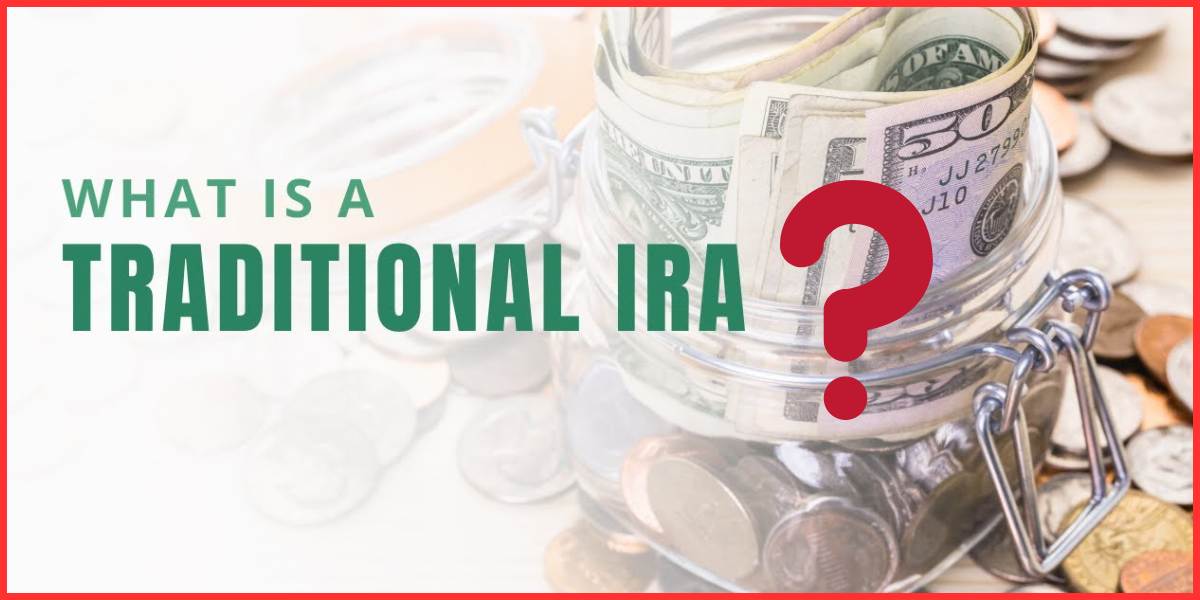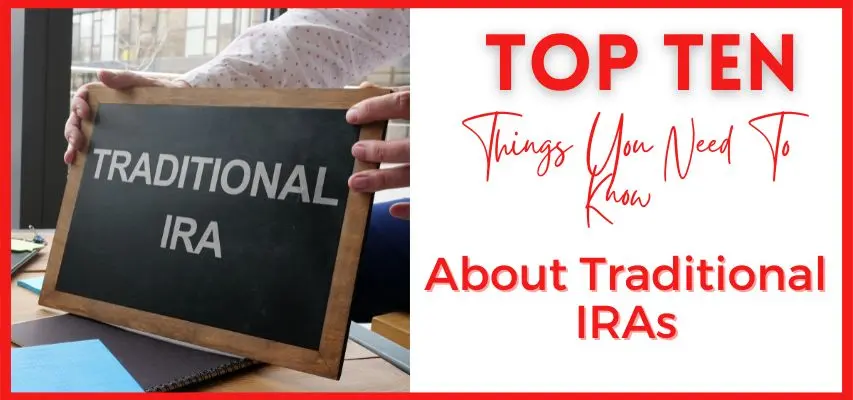Planning for retirement is a critical aspect of financial stability and security. Traditional Individual Retirement Accounts (IRAs) are a popular retirement savings vehicle that offer individuals tax advantages and a path towards a comfortable retirement. Whether you’re considering opening a Traditional IRA or already have one, it’s essential to understand the key aspects of this investment option. In this article, we will discuss ten important things you need to know about Traditional IRAs to make informed decisions about your retirement savings.
- You can have multiple traditional and Roth IRAs but your total cash contributions can’t exceed the annual maximum allowed by the IRS.
- You can choose from which account(s) you want to take your required minimum distributions when you reach age 73 if you have more than one traditional IRA.
- Anyone with earned income can contribute to a traditional IRA, regardless of their age.
- No age limit prohibits you from contributing to a Roth IRA, either.
- Distributions from a Roth IRA are tax-free.
A Traditional IRA is a type of retirement account that allows individuals to save money for retirement while enjoying potential tax advantages. The funds in a Traditional IRA are typically invested in various assets, such as stocks, bonds, mutual funds, or other investment vehicles. The contributions made to a Traditional IRA are tax-deductible, meaning they can lower your taxable income for the year. The investment earnings within the account grow tax-deferred until you start making withdrawals during retirement.
Also, read: Top 10 High-Yield Savings Accounts in the USA
IRA Myths Busted: 10 Things You Need to Know About Traditional IRAs
A Traditional Individual Retirement Account (IRA) is a popular retirement savings vehicle that offers tax advantages to individuals. If you’re considering opening a Traditional IRA or already have one, there are several key things you should know. In this article, we will discuss ten important aspects of Traditional IRAs to help you make informed decisions about your retirement savings.

1. Tax-Deductible Contributions
Contributions made to a Traditional IRA are often tax-deductible, meaning you can lower your taxable income for the year. However, there are income limits and eligibility criteria to consider. Consult with a tax professional to determine if you qualify for a deduction based on your specific circumstances.
2. Tax-Deferred Growth
One of the significant advantages of a Traditional IRA is the potential for tax-deferred growth. This means that any investment earnings within the account are not subject to current taxation. Instead, you only pay taxes when you withdraw the funds during retirement.
Also, read: Top 10 Low-Cost Investment Platforms for US Beginners in 2024
3. Required Minimum Distributions (RMDs)
Once you reach the age of 72 (70.5 if you turned 70.5 before January 1, 2020), the IRS requires you to start taking Required Minimum Distributions (RMDs) from your traditional IRA. RMDs are based on your life expectancy and the account balance. Failing to take the required distributions can result in significant penalties.
4. Early Withdrawal Penalties
If you withdraw funds from your Traditional IRA before reaching the age of 59½, you may be subject to early withdrawal penalties. In addition to the regular income taxes on the distribution, you may face a 10% penalty on the amount withdrawn. There are some exceptions to this rule, such as for first-time homebuyers or certain medical expenses, but it’s generally best to avoid early withdrawals if possible.
5. Contribution Limits
There are annual contribution limits for Traditional IRAs. As of 2021, the maximum contribution for individuals under the age of 50 is $6,000. If you are 50 or older, you can make an additional catch-up contribution of $1,000, bringing the total to $7,000. These limits are subject to change, so it’s essential to stay updated on the current guidelines.
Also, read: Top 10 Biggest Banks by Market Cap in the World 2024
6. No Income Limit for Contributions
Unlike some other retirement savings options, Traditional IRAs do not have income limits for contributions. This means that regardless of your income level, you can still contribute to a Traditional IRA. However, keep in mind that the tax deductibility of your contributions may be limited if you exceed certain income thresholds.
7. Spousal Contributions
If you are married and file a joint tax return, you can make contributions to a Traditional IRA on behalf of your spouse, even if they do not have earned income. This is known as a spousal IRA contribution and can be a useful strategy to maximize retirement savings for couples.
8. Non-Deductible Contributions
If your income exceeds the limit for deductible contributions to a Traditional IRA, you can still make non-deductible contributions. Non-deductible contributions do not provide an immediate tax benefit, but they can still grow tax-deferred within the IRA. It’s important to keep track of your non-deductible contributions to avoid double taxation when you withdraw funds.
Also, read: Top 10 Financial Literacy Resources to Educate Yourself About Money Management
9. Conversion to Roth IRA
It is possible to convert a Traditional IRA to a Roth IRA. This process involves paying taxes on the amount converted, as Roth IRAs are funded with after-tax dollars. Converting to a Roth IRA can offer tax advantages in the long run, especially if you expect to be in a higher tax bracket during retirement.
10. Estate Planning Considerations
Traditional IRAs can play a role in estate planning. It’s essential to designate beneficiaries for your account. If you pass away, the beneficiary will inherit the IRA and will be subject to distribution rules based on their age and relationship to you. Updating your beneficiary designations regularly ensures that your assets are distributed according to your wishes.
Understanding these ten key aspects of Traditional IRAs can help you make informed decisions about your retirement savings strategy. It’s always advisable to consult with a financial advisor or tax professional to ensure you are maximizing the benefits of your Traditional IRA while complying with all relevant rules and regulations. Remember, the primary purpose of a Traditional IRA is to provide you with a secure and comfortable retirement, so plan accordingly and start saving early.
Also, read: Top 10 Financial Apps to Simplify Your Money Management in 2024
Benefits of Traditional IRAs
- Tax-Deductible Contributions: Contributions made to a traditional IRA are often tax-deductible, reducing your taxable income for the year and potentially providing immediate tax savings.
- Tax-Deferred Growth: The investment earnings within a Traditional IRA grow tax-deferred, allowing your savings to compound over time without being subject to annual taxation.
- Required Minimum Distributions (RMDs): Once you reach the age of 72 (70 if you turned 70 before January 1, 2020), the IRS requires you to start taking Required Minimum Distributions (RMDs) from your Traditional IRA. These distributions ensure that you gradually withdraw the funds and pay taxes on them as you enter retirement.
- Early Withdrawal Penalties: Withdrawing funds from your traditional IRA before the age of 59½ may result in early withdrawal penalties. It’s generally advisable to avoid early withdrawals to preserve the tax advantages and allow your savings to grow.
- Contribution Limits: There are annual contribution limits for traditional IRAs. As of 2021, individuals under the age of 50 can contribute up to $6,000 per year, while those aged 50 and older can make an additional catch-up contribution of $1,000, bringing the total to $7,000.
- No Income Limit for Contributions: Traditional IRAs do not have income limits for contributions, allowing individuals with higher incomes to make contributions and benefit from the tax advantages. However, the tax deductibility of contributions may be limited based on income thresholds.
- Spousal Contributions: Married individuals filing joint tax returns can make contributions to a traditional IRA on behalf of their non-working or low-earning spouse, known as spousal contributions. This strategy can help maximize retirement savings for couples.
- Non-Deductible Contributions: If your income exceeds the limit for deductible contributions, you can still make non-deductible contributions to a traditional IRA. While these contributions do not provide immediate tax benefits, they can still grow tax-deferred within the IRA.
- Conversion to Roth IRA: Traditional IRAs can be converted to Roth IRAs, which are funded with after-tax dollars. This conversion involves paying taxes on the amount converted but can offer long-term tax advantages, especially if you anticipate being in a higher tax bracket during retirement.
- Estate Planning Considerations: Traditional IRAs can play a role in estate planning. Designating beneficiaries for your account ensures that your assets are distributed according to your wishes and allows beneficiaries to take advantage of distribution rules based on their age and relationship to you.
Also, read: Ten tips for repaying a loan
FAQs on Traditional IRAs
1. Can I contribute to a traditional IRA if I already have a retirement plan through my employer?
Yes, you can contribute to a traditional IRA even if you have a retirement plan through your employer. However, the deductibility of your contributions may be limited based on your income and participation in an employer-sponsored plan.
2. Can I contribute to a traditional IRA after I reach the age of 72?
No, you cannot contribute to a traditional IRA after reaching the age of 72. However, if you have earned income from working, you can still contribute to a Roth IRA.
3. What happens if I withdraw funds from my traditional IRA before the age of 59½?
If you withdraw funds from your traditional IRA before the age of 59½, you may be subject to early withdrawal penalties in addition to regular income taxes on the distribution. There are some exceptions to the penalty, such as for first-time homebuyers or certain medical expenses, but it’s generally best to avoid early withdrawals if possible.
Also, read: Top 10 Private student loan repayment assistance programs
4. Can I convert my Traditional IRA to a Roth IRA?
Yes, it is possible to convert a Traditional IRA to a Roth IRA. However, keep in mind that you will need to pay taxes on the amount converted, as Roth IRAs are funded with after-tax dollars.
5. What happens to my Traditional IRA when I pass away?
When you pass away, your Traditional IRA will be inherited by your designated beneficiaries. The beneficiaries will be subject to distribution rules based on their age and relationship to you. It’s important to regularly update your beneficiary designations to ensure that your assets are distributed according to your wishes.
Remember, while this article provides a comprehensive overview of Traditional IRAs, it’s always advisable to consult with a financial advisor or tax professional for personalized advice based on your specific situation. Start planning for retirement early and take advantage of the tax benefits offered by Traditional IRAs to secure a comfortable future.
Conclusion: The Final words
Traditional IRAs offer individuals a tax-advantaged way to save for retirement, with potential tax deductions for contributions and tax-deferred growth. Understanding the key aspects of traditional IRAs, such as contribution limits, required minimum distributions, and early withdrawal penalties, is crucial for making informed decisions about retirement savings. Consult with a financial advisor or tax professional to tailor a traditional IRA strategy that aligns with your financial goals and circumstances.
Also, read: Top Ten Roth IRA Strategies for 2024 Retirement Planning


































